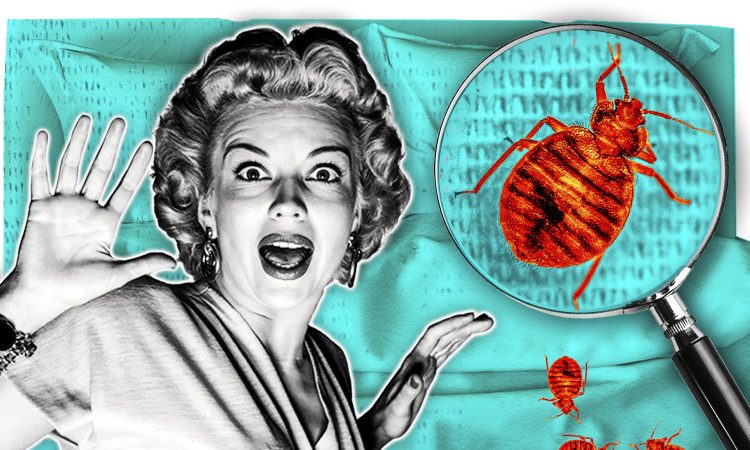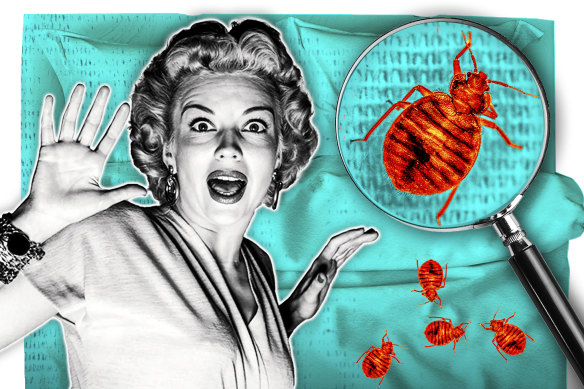Save articles for later
Add articles to your saved list and come back to them any time.
Key points
- Bed bugs are tiny parasites that feed on human blood.
- Detection is the most important step when dealing with a bed bug problem.
- Always seek professional help at the first sign of bed bugs.
As the world’s most stylish people trotted around Paris earlier this month for fashion week, designers and runway shows weren’t the talk of the town. Instead, everyone was speaking about bed bugs.
The city of lights has been plagued by an army. The pest has been spotted on the Paris metro, at Charles de Gaulle airport and in cinemas, homes and hotels. And with the 2024 Olympic Games on the horizon, public health officials are scrambling to control the outbreak. But how concerned should Australians be about a similar outbreak reaching our shores?
Bed bugs are nocturnal creatures, and can be hard to detect. Credit: Monique Westermann; Getty Images
In Australia, bed bugs are fairly prevalent, but less common than in other countries around the world, says Stephen Doggett, director of Medical Entomology at NSW Health Pathology and leading bed bug expert in Australia.
This is, in part, due to the government’s proactive approach at “educating all stakeholders in effective bed bug management” through an industry code of practice, authored by Doggett. And while he says there is no evidence that bed bugs are becoming more prevalent in Australia, they are expected to increase with more people travelling post-COVID.
Emma Mendelsohn, operations manager of Noah’s Ark Pest Control in Melbourne and chair of the Australian Environmental Pest Managers Association, says spikes tend to occur during peak holiday times. She says they’re also common in motorhomes and student accommodation, due to high people turnover.
So, will the French pests find their way here? “Bed bugs are carried all around the world by travellers, and so it is inevitable that bed bugs will be carried from France to Australia in people’s luggage or belongings,” says Doggett.
What are bed bugs?
Bed bugs are tiny parasites that feed exclusively on human blood. They’re wingless creatures, but excellent hitchhikers, travelling and spreading via clothing or in human belongings. While they don’t spread disease, their bites are extremely irritating, and can lead to discomfort, loss of sleep and psychological distress.
As their name suggests, they’re nocturnal insects, meaning they can be hard to detect during the day, and can survive for long stretches of time without feeding.
What causes bed bug infestations?
There are many complex factors that can cause higher rates of bedbugs, but they include:
- High levels of tourism and people turnover
- Lack of interest in effective management by governments
- High levels of low-income housing and poverty, as managing bed bugs can be expensive
- High-density housing
- A lack of government regulations when it comes to accommodation providers in providing a safe and clean environment
Because of the many causes of bed bugs, Doggett says they can be difficult and expensive to control.
How to check for bed bugs
Detection is the most important step when dealing with a bed bug problem, but they can be hard to find. When arriving at accommodation, Doggett says travellers should put their luggage in the middle of the room, pull the bed away from the wall, and remove all bedding. Then look for bed bugs and their poo spots (that resemble tiny black or dark brown stains), playing close attention to the mattress seams closest to the wall.
Mendelsohn says she always tries to keep her belongings contained in a hotel room, avoiding putting luggage on the bed and clothing in drawers. She adds that it’s a good sign if a mattress has a plastic protector on it.
At home, bed bugs can be found just about anywhere, but they especially love cracks and crevices. People can also easily spread them around unwittingly. “They might start in the bedroom, but if you’re wearing slippers they can then spread to other rooms,” says Mendelsohn.
They are also attracted to heat. Mendelsohn says it’s common to find bed bugs clustered around things like electric wall plates.
How to get rid of bed bugs
Doggett cautions people against attempting to deal with a bed bug infestation themselves, as they are one of the most difficult pests to eradicate. Instead, seek professional help, and look for pest managers who are part of the Australian Environmental Pest Managers Association, as they are held to a strict code of conduct.
“People can easily re-infest themselves,” says Mendelsohn.
For personal belongings, she says clients are always instructed to use heat. Clothing, bedding and other textiles should be put in a hot wash of at least 60 degrees and run through the dryer. Shoes can be put in a black plastic bag and left to sit in the hot sun.
When travelling, Mendelsohn suggests asking hotel staff for a steamer and running it over clothing, bedding and the outside of your luggage upon arrival. It is also a good idea to seal clothing in plastic zip-lock bags to reduce the risk of cross-contamination.
Finally, when arriving home, unpack suitcases outside or in the garage. Treat clothing and shoes as above, and inspect items closely before putting them away.
Make the most of your health, relationships, fitness and nutrition with our Live Well newsletter. Get it in your inbox every Monday.
Most Viewed in Lifestyle
From our partners
Source: Read Full Article

